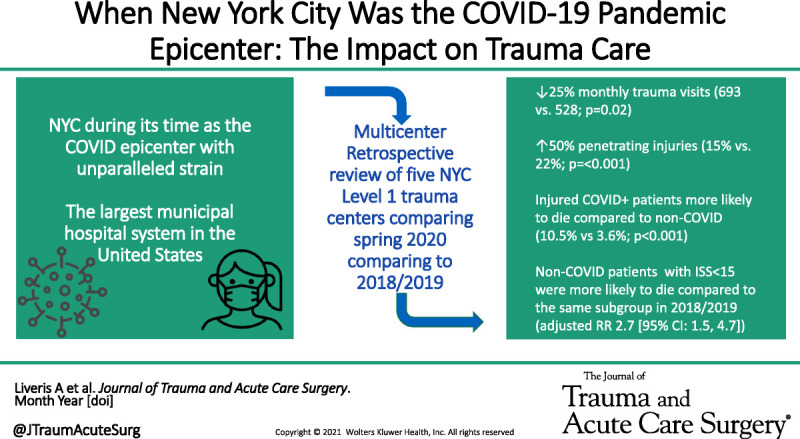- Record: found
- Abstract: found
- Article: not found
When New York City was the COVID-19 pandemic epicenter: The impact on trauma care

Read this article at
Abstract
A large multicenter study shows an increased mortality risk to trauma patients during a time when NYC was considered the epicenter for COVID-19. Non-COVID patients with ISS<15 were more likely to die compared to the same subgroup in 2018/2019.
BACKGROUND
During early spring 2020, New York City (NYC) rapidly became the first US epicenter of the COVID-19 pandemic. With an unparalleled strain on health care resources, we sought to investigate the impact of the pandemic on trauma visits and mortality in the United States' largest municipal hospital system.
METHODS
We conducted a retrospective multicenter cohort study of the five level 1 trauma centers in NYC's public health care system, New York City's Health and Hospitals Corporation. Clinical characteristics, mechanism of injury, and mortality of trauma patients presenting during the early pandemic (March 1, 2020, to May 31, 2020) were compared with a similar period in the previous 2 years. To account for important patient and hospital-level confounding variables, we created a propensity score for treatment and applied inverse probability weighting.
RESULTS
In March to May 2020, there was a 25% decrease in median number of monthly trauma visits (693 vs. 528; p = 0.02) but a 50% increase (15% vs. 22%; p = <0.001) in patients presenting for penetrating injuries, compared with the same period for 2018 and 2019. Injured patients with COVID were significantly more likely to die compared with those without COVID-19 (10.5% vs. 3.6%; p < 0.001). Overall, there was no significant difference in mortality for non–COVID-injured New Yorkers cared for in 2020 compared with 2018 and 2019. Less severely injured non-COVID patients (Injury Severity Score, <15), however, were significantly more likely to die compared with this same subgroup in 2018 and 2019 (adjusted relative risk, 2.7 [95% confidence interval, 1.5–4.7]).
CONCLUSION
Despite a decline in overall trauma visits during the early part of the COVID pandemic in NYC, there was a significant increase in the proportion of penetrating mechanisms. Less-injured non-COVID patients experienced an increase in mortality in the early pandemic, possibly from a depletion of human and hospital resources from the large influx of COVID patients. These data lend support to the safeguarding of trauma system resources in the event of a future pandemic.
Abstract
Related collections
Most cited references21
- Record: found
- Abstract: found
- Article: not found
A Novel Coronavirus from Patients with Pneumonia in China, 2019
- Record: found
- Abstract: found
- Article: not found
An interactive web-based dashboard to track COVID-19 in real time
- Record: found
- Abstract: found
- Article: not found

